Lecture5(1) Phrase Hierarchy 当代语言学导论课件
- 格式:ppt
- 大小:533.00 KB
- 文档页数:26

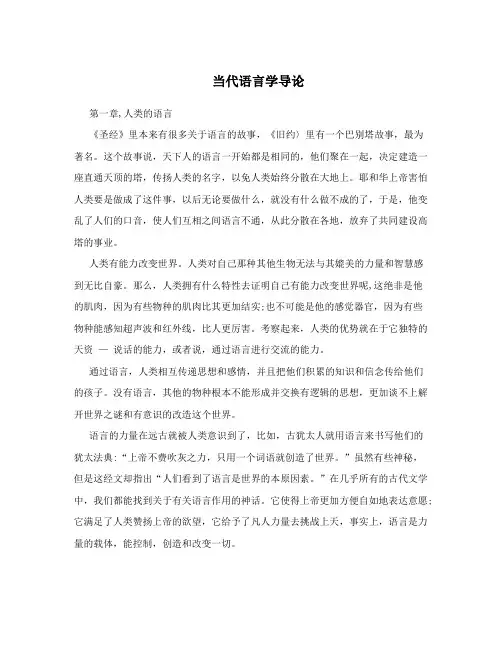
当代语言学导论第一章,人类的语言《圣经》里本来有很多关于语言的故事,《旧约〉里有一个巴别塔故事,最为著名。
这个故事说,天下人的语言一开始都是相同的,他们聚在一起,决定建造一座直通天顶的塔,传扬人类的名字,以免人类始终分散在大地上。
耶和华上帝害怕人类要是做成了这件事,以后无论要做什么,就没有什么做不成的了,于是,他变乱了人们的口音,使人们互相之间语言不通,从此分散在各地,放弃了共同建设高塔的事业。
人类有能力改变世界。
人类对自己那种其他生物无法与其媲美的力量和智慧感到无比自豪。
那么,人类拥有什么特性去证明自己有能力改变世界呢,这绝非是他的肌肉,因为有些物种的肌肉比其更加结实;也不可能是他的感觉器官,因为有些物种能感知超声波和红外线,比人更厉害。
考察起来,人类的优势就在于它独特的天资—说话的能力,或者说,通过语言进行交流的能力。
通过语言,人类相互传递思想和感情,并且把他们积累的知识和信念传给他们的孩子。
没有语言,其他的物种根本不能形成并交换有逻辑的思想,更加谈不上解开世界之谜和有意识的改造这个世界。
语言的力量在远古就被人类意识到了,比如,古犹太人就用语言来书写他们的犹太法典:“上帝不费吹灰之力,只用一个词语就创造了世界。
”虽然有些神秘,但是这经文却指出“人们看到了语言是世界的本原因素。
”在几乎所有的古代文学中,我们都能找到关于有关语言作用的神话。
它使得上帝更加方便自如地表达意愿;它满足了人类赞扬上帝的欲望,它给予了凡人力量去挑战上天,事实上,语言是力量的载体,能控制,创造和改变一切。
在剑桥语言大百科全书里,用了以下的说法来描述语言在人类生活中所起的中心作用:当我们观察自己周围的时候,会情不自禁的对那几千种表达不同世界观,文学和生活方式的语言和方言而倍感震撼。
当我们回顾前辈的思想时,我们只能看到自己语言范畴之内的东西,当我们瞻望未来,我们只能够用语言去计划前程;当我们放眼宇宙,通过飞船向太空发出信号,告知可能存在的关心我们的天外居民我们所在位置时,用的都是语言。
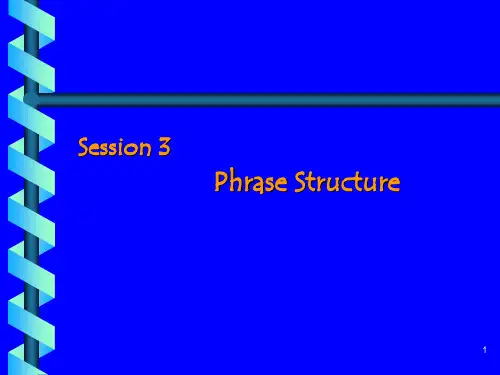
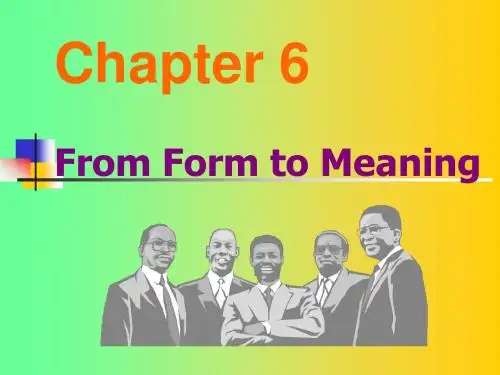
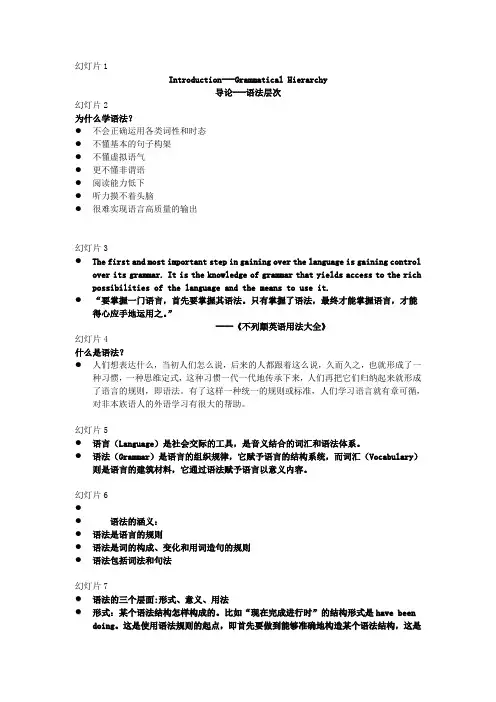
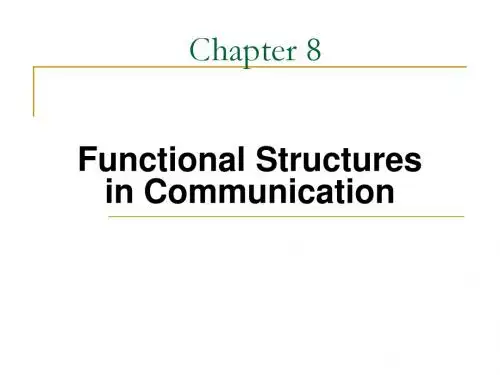

当代语言学导论课后练习第一题答案黎神华桂林电子科技大学Language touches every part of our lives; it gives words to用言语表达our thoughts, voice to our ideas, and expression to our feelings. It is a rich and varied human ability—one that we can use without even a thought, that children seem to acquire automatically, and that linguists have found to be complex yet describable.语言贯穿于我们生活的全部,予我们的思维以言辞,予我们的理念以话语,予我们的情感以表述。
它是一种人类所拥有的丰富而多样的能力—想用就用,无须思索;天下儿童,自能习得;语言学家知其固然复杂,却可描述。
Linguistics is the study of the nature, structure, and variation of language, including phonetics, phonology, morphology, syntax, semantics, and pragmatics.语言学是研究语言的本质、结构和变化的科学,包括有语音学、音位学、形态学、句法学、语义学和语用学。
Linguistic knowledge as represented in the speaker’s mind is called a grammar. Linguistic theory is concerned with涉及revealing揭示the nature of the mental grammar心理语法which represents speakers’ knowledge of their language.语言学知识作为说话者大脑里的表述被称为语法。
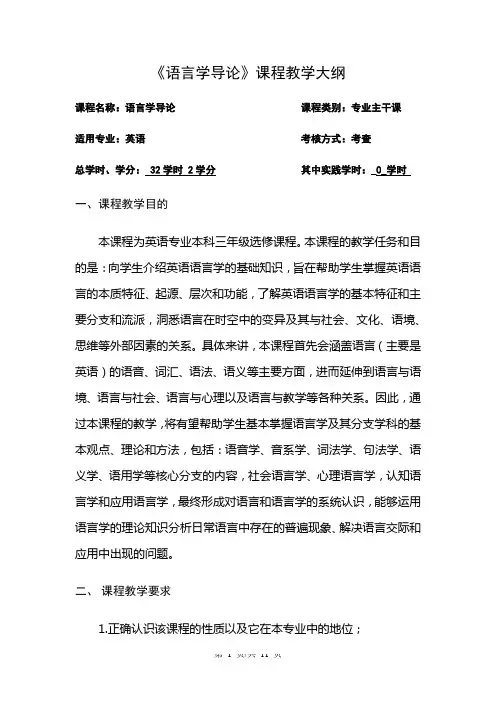
《语言学导论》课程教学大纲课程名称:语言学导论课程类别:专业主干课适用专业:英语考核方式:考查总学时、学分: 32学时 2学分其中实践学时:_0_学时一、课程教学目的本课程为英语专业本科三年级选修课程。
本课程的教学任务和目的是:向学生介绍英语语言学的基础知识,旨在帮助学生掌握英语语言的本质特征、起源、层次和功能,了解英语语言学的基本特征和主要分支和流派,洞悉语言在时空中的变异及其与社会、文化、语境、思维等外部因素的关系。
具体来讲,本课程首先会涵盖语言(主要是英语)的语音、词汇、语法、语义等主要方面,进而延伸到语言与语境、语言与社会、语言与心理以及语言与教学等各种关系。
因此,通过本课程的教学,将有望帮助学生基本掌握语言学及其分支学科的基本观点、理论和方法,包括:语音学、音系学、词法学、句法学、语义学、语用学等核心分支的内容,社会语言学、心理语言学,认知语言学和应用语言学,最终形成对语言和语言学的系统认识,能够运用语言学的理论知识分析日常语言中存在的普遍现象、解决语言交际和应用中出现的问题。
二、课程教学要求1.正确认识该课程的性质以及它在本专业中的地位;2.在教学内容上,原则以刘润清、文旭编著的《新编语言学教程》为蓝本,但不拘泥于一种教材,教师可根据语言学研究的发展和成果,博采众长,适量取舍和补充;3.要讲清楚语言学的基本术语和概念,使学生通过该课程的学习能比较系统地掌握语言学基本知识,了解语言的特征和功能、语音、语义、语用知识以及语言与社会、语言与心理等方面的关系;4.能够通过理论与实例相结合抓住重点对理论简单扼要的阐述,结合与学生生活学习相关的实例对理论进行深入浅出地分析,提高学生分析解决问题的能力;5.要处理好语言学理论与语言实际应用的关系,语言学概念与语言实例的关系,语言学流派与语言学发展的关系,语言学各分支(或章节)之间的关系以及学生对语言学的了解与实际运用的关系。
三、先修课程1.英语语音2.英语语法3.词汇学四、课程教学重、难点该课程的教学重点是语言的本质特征,微观语言学(包括语音学、音系学、形态学、语义学和语用学等),以及宏观语言学(包括语篇分析、社会语言学、心理语言学、语言习得和应用语言学等);难点是音系学、语用学、语篇分析和应用语言学。

1.Human superiority lies in his unique endowment天赋—the ability to talk, or rather, tocommunicate by means of language.nguage is a vehicle of power, for control, for creation. And for change.3.The study of human language is called linguistics.nguage is the system of human communication which consists of the structuredarrangement of sounds(or their written representation) into larger units, e.g. morphemes, words, sentences, utterances.5.Varieties of language: Any particular language is in essence a set of varieties. There are localvarieties区域变体–dialects and accents(the former differ from each other in pronunciation, vocabulary, and even grammar; the latter only in pronunciation ), social varieties—sociolects 社会方言(=social dialects , used by people of different classes, ages, or sexes ), historical varieties—registers语域(e.g. formal English, scientific English), and even individual varieties—idiolects个人语言. Usually a language has an officially declared or generally considered standard dialect(e.g. Putonghua in China, General American in the US)6.Prescriptivism is the view that one variety of language has an inherently higher value thanothers.7.Descriptivism is the policy of describing languages as they are bound to exist. Usages ofdifferent varieties should be observed and recorded instead of being judged with some imposed norms.8.Plato’s problem: How can every human being develop a rich system of linguistic knowledgeon the basis of limited and fragmentary empirical evidence?9.Plato held that there was a universally correct and acceptable logic of language for man tofollow in expressing his ideas.10.Aristotle argued that knowledge of language was arrived at by convention and agreement ofthe speakers of a given language.11.In ancient China, Xun Zi reasoned that a name was accepted through public agreement, andthe appropriateness of naming a thing lay in convention.12.According to Chomsky, knowledge of language is the result of interaction of UG and laterexperience.13.(Ferdinand de) Saussure advocated the diversion of the focus of linguistic study fromdiachronic to synchronic.14.Chomsky’s epistemology of the knowledge of language foes as follows:1)Every human being has the language competence能力, because he has the inborn UGwhich other species lack.2)UG is the initial state of the human language faculty语言器官/机制which alone cannotenable a human baby to speak. A baby needs to be exposed to the linguistic environment of a certain language and accumulate experience.3)Due to the effect of later experience, the baby’s mind develops from the initial state intothe steady state, which corresponds to the competence of speaking a specific human language.15.Behaviorists’ or empiricists’ opinions are identical 统一的,同一的with Aristotle’s.16.Connectionism/ emergentism argues that the mental neural mechanisms responsible forboth lexical and grammatical processing are not unique to language.17.diachronic: focus on the comparison between languages and the exploration of the historicalchange and variation of some ancient languages./ of, relating to, or dealing with phenomena (as of language or culture) as they occur or change over a period of time18.synchronic: research of the facts of language agreed upon or shared by he members oflanguage community at a given point in time./ concerned with events existing in a limited time period and ignoring historical antecedents19.Galilean thesis ”nature is perfect”20.Fossilization is a process in which incorrect linguistic features become a permanent part ofthe way a person speaks a second language.21.Three adequacies:observational adequacydescriptive adequacyexplanatory adequacy(provide a descriptively adequate grammar for every natural language, and does so in terms of maximally constrained set of universal principles which represent psychologically plausible natural principles of mental computation.)22.A theory in science must not be pure speculation but testable at observational, descriptive,and explanatory levels.23.Science tells us that nature is a physical continuum连续体, which does not break itself intophysics, chemistry, psychology, linguistics…; these disciplines 学科are not facts but our decisions.24.Plato asserted that there was a”legislator” who gave the correct, natur al name toeverything, and languages belonged to states but not to individuals.25.J.G. Herder pointed out that babies’ cry is a sort of natural sounds , which could neverdevelop into a language.26.A cornerstone of science is Galilean’s intuition that nature is perfect.27.Sir William Johns first proposed that a language in South Asia be a relative of many Europeanlanguages .28.The origin of language as a topic was banned by the Linguistic Society of Paris founded in1866.29.In accordance with the three phases just mentioned, phonetics is divided into threesub-fields. Articulatory phonetics发音语音学studies speech production by the speech organs; acoustic phonetics声学语音学studies physical properties of speech sounds, the way sounds travel from the speaker to the hearer; and auditory phonetics听觉语音学studies the perception of speech sounds in the human auditory and cognitive system.30.A “sound”people say they produce is actually a combination of sounds called a syllable,which is often related to a chest pulse.31.The place of articulation refers to the point in the vocal tract at which the main closure ornarrowing is made so as to modify the flow of air from the chest to the mouth in producing a sound.32.The manner of articulation refers to the type of constriction收缩or movement that occursat any place of articulation.33.The production of different speech sounds through the use of these organs is known asarti culation.34.Vibration 颤动35.Adam’s apple area 喉结36.Consonants are sounds made by a closure in the vocal tract, or by a narrowing from whichair cannot escape without producing audible friction摩擦, and vowels are sounds in which there is no obstruction to the flow of air as it passes from the larynx to the lips.37.Bilabial双唇音, formed by bringing the lips together , e. g. [ p ] , [ m] . Here the function oflips is somewhat complicated: they both can be regarded as the active and passivearticulat ors simultaneously.bi o-dental唇齿音, formed by the lower lip against the upper teeth, e . g. [ f] .39.Dental齿音, formed by placing the tip of the tongue against the upper teeth, e . g. [ð].40.Alveolar齿龈音, formed by placing the tip or blade of the tongue against the alveolar ridge,e. g. [ t ] .41.Palatal腭音, formed by the front of the tongue against the hard palate, namely, the roof ofthe mouth, e . g. [ j] .42.Palato- alveolar腭龈音, formed midway between the places of articulation for palatals andalveolars: the blade ( and sometimes the tip) of the tongue articulates with the alveolar ridge, with a simultaneous raising of the front of the tongue towards the hard palate , e. g.[ʃ] .43.Velar软腭音, formed by the back of the tongue against the soft palate, e. g. [ k] .44.Glottal声门音, formed by the vocal cords coming together t o cause a closure or friction, e .g.[ h] .45.Retrofle卷舌音, formed when the apex of the tongue is curled back in the direction of thehard palate, as heard in many Indian English accents.46.Uvular小舌音, formed by the back of the tongue against the uvula, as heard in some accentsof French.47.Pharyngeal咽音, formed in the pharynx, the part of the throat above the larynx. Specifically,the front wall of t he pharynx articulates with the back wall , as hear d in Arabic .ans in the vocal tract, such as the lips, teeth, or hard palate, are called articulators.49.Consonants are also classified according to the manner of articulation, concerning whichphoneticians tend to consider several factors .50.The first factor is the degree of the constriction of airflow. At least six main classes can bedistinguished in English:51.Plosive爆破音, formed by completely closing the air passage and suddenly removing theobstacle , so that the air escapes making an explosive sound, e. g. [ p] ,[ d] . It belongs toa broader category called “stop” which includes closures produced by air streams not fromthe lungs , as encountered in some southern African languages.52.Nasal鼻音, formed with the soft palate lowered, thus allowing air to resonate in the nose,e . g. [ m] .53.Affricate塞擦音, a consonant which starts as a plosive, but instead of ending with plosion,ends with a fricative made in the same place, e. g. [tʃ ] .54.Liquid流音, formed by some obstruction of the air stream in the mouth, which seems notenough to cause any real constrict ion or friction, e. g. [ l] , [ r ]. [ l] is cal led a lateral liquid, because in making it, an obstacle is placed in the middle of the mouth, leaving the air free to escape at one or both sides.55.Fricative擦音, formed by a narrowing of the air passage at some point so that the air inescaping makes audible frication. e. g. [ f] , [ z] . Some fricatives are also cal led sibilants齿擦音, which are made with a groove- like structure in the front part of the tongue, producing a kind of hissing sound, e. g. [ s] , [ʃ] .56.Glide滑音, sometimes called semi -vowel because it is typically produced with the tonguemoving, or “gliding”, to or from the position of a nearby vowel, e.g. [ h] , [ w] .57.The second factor is voicing. Voice is caused by the vibration of the vocal cords.58.The third factor is aspiration. This is the sound of air rushing through the vocal tract, usuallyfound after the release of plosive consonants in some situation.59.Different vowels result from changing the shape of the mouth; all of them are voicedcontinuous sounds.60.[i:] close vowels , [a:] open vowels, [e] semi-closed vowels, [ɔ:] semi-open vowels61.Four rounded vowels: [u:] [u] [ɔ:] [ɔ], they are all back vowels.62.[a:]is the only English back vowel that occurs without lip rounding.63.There is another interesting rule: all the long vowels( e.g. [i:] [u:])are tense vowels紧元音,and all the short vowels ([i] [u]) are lax vowels松元音.64.Every vowel constitutes a single syllable. The vowel can be a monophthong, a diphthong, oreven a triphthong that contains three distinctive qualities, e.g.[ai ə]. However, not every syllable contains a vowel. The second syllable of the word little[litl] has no vowel after the plosive [t] but a liquid [l].65.Phonemes have no meaning of themselves, but they are the smallest linguistic unit, whosechange will lead to the change of meaning. A phoneme is defined as the smallest unit of sound in a language which can distinguish two words.66.Allophone is the phonetic variant of a phoneme, which can be substituted of anotherwithout bring about a change of meaning.67.Phoneme用//; allophone用[]68.A phonetic property特性,特质that distinguishes phonemes from one another is called adistinctive feature.69.Phonetics is more specifically the study of how speech sounds are produced, what theirphysical properties are, and how they are interpreted.70.Phonology, is a description of the sounds of a particular language and the rules governingthe distribution of those sounds. Furthermore, phonology is also concerned with the universal properties of natural language sound systems and aims at revealing the general principles of the sound patterns of all languages.71.Pitch is the auditory sensation of the height of a sound.72.There are two ways in which languages make use of pitch variations in speech.1)In languages such as English, French, and German, regular sequences of different pitchescharacterize stretches of speech between pauses and are known collectively as intonation. The differences of intonation may correlate with different types of utterances.2)In languages such as Chinese , Vietnamese, Thai, and Zulu, pitch differences help todistinguish one word from another and may be the only differentiating feature between two or more words whose composition is the same in terms of consonants and vowels.Pitch differences used in these ways are called tones and these languages are called tone languages.73.Stress, pitch, tone and intonation are also called suprasegmentals超切分音位because theyrelate to aspects of pronunciation that go beyond the production of individual segments.rynx喉: the beginning of the vocal tract, containing the vocal cords.75.Pharynx咽: the tube-like passage in the throat which connects the larynx to the upper partof the vocal tract.76.Vocal cords声带:two muscular folds in the larynx that vibrate as a source of sound.77.Soft palate 软腭:the backward continuation of the roof of the mouth, which can be loweredto let air pass through the nose.78.Hard palate 硬腭:the roof of the mouth79.Alveolar ridge 齿龈脊:the bony prominence behind the upper front teeth.80.Trachea 气管:the passage between lungs and larynx.81.Segment is the smallest unit that can be identified in continuous speech.82.A syllable cannot contain more than one vowels. Even if a diphthong or thiphthong iscontained, it is still a single vowel, pronounced within one chest pulse.83.Words are not the smallest unit of meaning. They are composed of smaller units of meaning,called morphemes. Morphemes are the minimal language units.Morphology deals with word structure. Many words are themselves morphemes, such as big and book. They cannot be broken into smaller units that in themselves carry meaning. We call them free morphemes—morphemes that can stand alone as a word. Many other words are created by joining together two morphemes, e.g. blackboard, in which the two morphemes black and board can be recognized as meaningful words by themselves. So they are also free morphemes .84.Another type of morpheme is the bound morpheme , which occurs only when attached toanother morpheme, such as -ly in happily and un- in unhappy.The function of an affix can be derivational派生的,衍生的or inflectional屈折的. A derivational morpheme is one that is added to a root to form a new word that differs, usually, in its part-of-speech词性classification. For example, when the suffix -ness is added to the adjective happy, the noun happiness is formed.85.Prefixes as derivational morphemes usually change the basic meaning of a word but do notchange its part- of-speech classification .(即系本来系动词就系动词)86.An inflectional morpheme indicates certain grammatical properties associated with nounsand verbs, such as gender , number , case, and tense. Unlike highly inflected languages such as Latin , English has very few inflectional morphemes. In English, the inflectional morphemes are all suffixes. The suffix -s, which indicates plurality in nouns as well as the third-person singular in verbs, is an inflectional morpheme ; the past tense suffix -ed, which is added to verbs, is another .87.According to Wilhelm von Humboldt , languages of the world can be classifiedmorphologically into three types: isolating, inflecting, and agglutinating.88.An isolating language is also called an analytic language or root language, in which all thewords are invariable. Chinese, Vietnamese and Samoan are typical cases. An inflecting language is also called a synthetic language or fusional language, in which grammatical relationships are expressed by changing the internal structure of the words—typically by the use of inflectional endings which express several grammatical meanings at once. Latin, Greek, and Arabic are clear cases. An agglutinating language is also called agglutinativelanguage, in which a word typically consists of a neat linear sequence of morphemes, all clearly recognizable. Turkish, Finnish, Japanese, and Swahili are usual cases.pounding is a process that forms new words not by means of affixes but from two ormore independent words. Compounds are different from phrases in that they symbolize an integrated整体的concept.90.There are different semantic relationships within the morphemes comprising a compound.91.Idiomatic 惯用的,成语的expressions: metaphoric(e.g. I’m really tied up无法分身.),allusive(e.g. the ruling party met its Waterloo 毁灭性的打击in the new election.), a majority are institutionalized.92.Morphology is the study of word-making and word-marking. On the one hand, morphologyexamines relationships between words and the ways in which these connections are indicated. On the other, morphology looks at how grammatical relationships between words are marked. Different languages focus on different word relationships, and they make use of different patterns of marking.93.The study of the internal structure of words, and of the rules by which words are formed, iscalled morphology.94.Words are not the most elemental sound-meaning units. The most elemental grammaticalunits in a language are morphemes.95.Bound morphemes like “a-”, “pre-”, “-ly”, “-ness”, which have only grammatical meanings,are limited in number, about 100 in English.pounds are different from phrases in that they symbolize an integrated concept.Phonologically, they have primary stress on the first word only, while individual words in phrases have independent primary stress .97.Modern linguistic research suggests that language is intrinsically 内在的,本质的less literalthan we have always assumed. It is abundant in idiomatic expressions .nguages of the world can be classified morphologically into three types: isolating,inflecting, and agglutinating.99.The tree relationship is non-linear but hierarchical.100.Family tree sequence次序—top-down; syntactic tree sequence—bottom-up.101.The bottom-up process in sentence production is called merging合并.102.A head of a phrase is the key word which determines the properties of the phrase.103.The I( inflectional morpheme) plays an essential role in merging an NP and a VP into a sentence.104.Besides a labeled tree-diagram, this hierarchically arranged structure with in a sentence can also be represented in the form of labeled bracketing.105.There are two groups of syntactical categories: lexical categories and functional categories.All the content words, namely nouns, verbs, adjectives, and adverbs, belong to lexical categories ; on the other hand, any word or morpheme which has no descriptive content and which serves an essentially grammatical function belongs to a functional category. A functional category plays a role like glue in combining content words into phrases and phrases into a sentence .106.XP can be defined as the maximal projection headed by X, and X itself, i. e. the head, as the minimal projection.107.I is a category devised by Chomsky whose members include not only inflectionalmorphemes but also finite auxiliaries限定助动词( which are inflected for tense / agreement ) , and the infinitival particle to.108.When a constituent is made the topic of a sentence, it may be moved into a more prominent position at the front of the sentence. This process is called topicalization话题化—A device which marks sth as a topic by simply moving the topic to the front of the sentence, as in This book I can’t recommend.109.Syntax is the subfield of linguistics that studies the internal structure of sentences and the relationship among their component parts.110.In the VP draw a tree, draw is the head of the phrase while a tree is the complement. 111.A phrase is the projection of the head. XP can be defined as the projection headed by X, X’ , as the intermediate projection, and X itself, i . e. the head , as the minimal projection. 112.According to X-bar theory, head X can either be a lexical category, such as nouns and verbs, or a functional category.113.In the skeleton骨架,框架of XP, SPEC stands for specifier and COMP stands for complement. SPEC and X’ are sisters. So are X and COMP.114.IP refers to inflectional phrase. I, a functional category, includes not only inflectional morphemes but also finite auxiliaries, and the infinitival particle to.115.CP refers to complementizer phrase and can be found in analysis of complex sentence as well as wh-questions and topicalization.116.When we put a sentence in out mind by reading or listening, our mind will immediately treat it as a set of meaning units, called propositions.117.An intransitive verb—1 NP—the subject(external argument); a simple transitive verb—2 NPs—subject(external argument) and object(internal argument); a ditransitive verb 双宾语动词---3 NPs—subject(EA), direct object and indirect object(IA); an unusual verb in English, rain, requires no NPs.118.NPs required by a verb are called its arguments论元.119.A verb very often permits some further phrases, which are optional. These optional phrases are adjuncts附加成分,修饰成分, which are expressed most often as prepositional phrases or adverbial phrases in English.120.Theta theory(orθ-theory)题元角色is concerned with assigning指定thematic roles(θ-role)论旨角色to the arguments of verbs.121.Theta-roles:1)Agent: instigator发起者of some action. E.g. John threw the ball.2)Theme: entity实体,实质undergoing the effect of some action. Often a theme isaccusative宾格(and can be called a patient as well), e.g. John hit the cat; however, it is nominative主格with a few verbs like fall, die, etc. e.g. The cat (accusative)died.3)Experiencer: entity experiencing some psychological state. E.g. John was happy.4)Benefactive: entity benefiting from some action. E.g. Mary bought some chocolate forJohn.5)Recipient: entity receiving some entity. E.g. John got Mary a present(patient).6)Instrument: means by which sth comes about. E.g. Joanna dug the garden with a spade.7)Locative: place in which sth is situated. E.g. John put the washing in the bin.8)Goal: entity towards which sth moves. E.g. Mary passed the plate to John.9)Source: entity from which sth moves. E.g. John returned from London.122.Theta theory enables us to reveal some semantic differences that are not reflected in the syntactic structure demonstrated by X-bar tree diagrams.123.As for verbs, the lexicon contains information about their transitivity, their argument structure , and the theta roles that can be assigned to their arguments.124.和动词最密切的是theme,及物动词的theme是object,不及物动词的theme是subject? 125.The output of the grammatical system consists of two levels of description: the phonetic description for the generated sentence to be spoken out ; the semantic description which logically represents the meaning the speaker would like to convey through uttering the sentence.126.Logicians have long been concerned with formulating representations for the semantic structure of sentences, or more correctly propositions. NPs required by a verb are called its arguments. A proposition comprises a predicate V and a set of arguments. In addition to its arguments , a verb very often permits some optional phrases which are called adjuncts. 127.The internal argument of a verb has to be realized inside the maximal projection of that verb.The external argument of a verb is not contained in the maximal projection of that verb .For example, in John [ (VP) buys books ] , John is the external argument and books is the internal argument of the verb buy.128.E ach verb may have none or one internal argument( s) . Each verb may have none, one or more internal argument(s).129.Each argument is assigned one and only one theta/ thematic role. Each theta/thematic role is assigned to one and only one argument.nguage is symbolic, but not all symbols belong to language. In addition to symbols, there are icons and indexes which also convey meaning. Picasso is an icon of modernism; smoke is an index of fire. Such relationships are beyond the reach of semantics. They are the research objects of a more general field called semiotics, which investigates the types of relationships that may exist between a sign and the object it represents . Semantics can be regarded as a part of this extensive effort, with its particular emphasis on linguistic meaning.Therefore, John I. Saeed, a contemporary authority in this field, proposes a more proper definition: semantics is the study of meaning communicated through language.nguage is the vehicle, and meaning is the cargo.132.Every argument has a theta role assigned from the predicate according to the theory.133.Semantic features are defined as a class of theoretical constructs developed in analogy to the distinctive features of phonology—they are considered to be the smallest semantic units for the description of linguistic expressions and their semantic relations.134.She was the only man in her cabinet.Man---hard, iron handy. The word man is used as a metaphor. When a word is used as a metaphor, it will not keep all the features of its conceptual meaning, but will highlight a certain associative property of its connotative meaning, according to Leech.135.Saussurean arbitrariness, which claims that the relationship between a linguistic sign( signifier) and its content ( signified) is arbitrary.136.According to Ogden and Richards, the “symbol” refers to the linguistic elements(word, sent ence, etc.), the”referent” refer s to the object in the world of experience, and the “thought”“reference” refers to concept or notion.Ogden& Richards’ Semantic Triangle137.Most signs have at least one normal, “common sense” meaning, called the sign’ denotaion, is shared among many people and is the most widely used meaning of the sign. But signs may also have many different ”subjective”meanings that arise from each individual’ personal experiences. These are called the connotations of the sign.138.Meaning falls into at l east two categories--denotative and connotative. A concept in an individual’s mind is mostly the connotative meaning, formed through one’s perception of some features of the object a sign refers to. The denotative meaning is not necessarily generated in such a process, but has long been an agreement among all the people in a community.139.Pierce’s“Semiotic Triangle”Charles S. Pierce is generally acknowledged as an important pioneer in the study of signs.Perception--the ongoing group of bodily processes by which human beings receive data about their environmentsExperience--the memory of previous perceptions and concepts, which is constantly being altered or “updated” by new experienceConvention--the constantly changing social “rules of meaning” that unify groups of people within their communication environments.140.Some semantic properties of the words we use to think and talk about the world are automatically captured by the resources of our human minds.141.All these dimensions of internalized semantic knowledge, namely a)synonymy同义,b)contradiction反义, c)entailment蕴含, d) presupposition前提, e) ambiguity,f)inclusive-exclusive distinction, g) metaphorical interpretation, h) infelicity不恰当, can beattributed to properties of I-meaning proposed by Chomsky ( 2000 ).142.The semantic properties of words are used to think and talk about the world in terms of the perspectives made available by the resources of the mind.143.I-meaning is the human genetic faculty in calculating the logic in meaning ( e. g.presupposition, entailment.. . ) .144.The real meaning in communication is contextual meaning. Without context, a sentence conveys only literal information.145.Words or expressions that have identical meanings are called synonyms.146.Words or phrases that have opposite meanings are called antonyms.147.When a word has two or more meanings that are at least vaguely related to each other, it is called a polysemy多义词. For example, “leaf” can refer to “a part of a tree” and also “a sheet of paper”.148.When words have a single phonetic form but two or more entirely different meanings, they are called homophones同音字,同音异形异义词. For example,“bank”can mean “a commercial lending institution” and ”a small cliff at the edge of a rive”.149.When words have two kinds of meanings: denotative and connotative. Denotative meaning is precise, literal, and object. You can find a word’s denotative from a dictionary.150.Connotative meaning is more variable, figurative比喻的, and subjective. It is whatever the word suggests or implies. Connotative meaning includes all the feelings, associations, and emotions that a word touches off in different people .151.The relation of entailment that holds between ”chase” and “follow” is based on properties of I-meaning.。

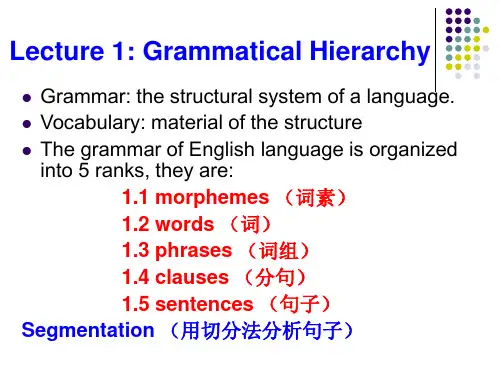
当代语言学导论本文以《当代语言学导论》为标题,研究了当代语言学及其重要概念。
首先,本文介绍了语言学研究中应用的基本方法,语言学家研究语言变化和语言系统的重要理论。
其次,本文讨论了语言学的重要概念,比如语法、语义、语用和社会语言学。
最后,本文简要介绍了对当代语言学的研究及其影响的一些研究成果。
Introduction:随着现代社会的发展,语言学及其研究也受到越来越多关注。
语言学是研究语言的科学,它分析了人类语言的历史、形式、用法、变化以及不同语言之间的关系。
本文以《当代语言学导论》为标题,旨在介绍当代语言学及其重要概念,并对当代语言学研究及其对其他语言研究领域的影响进行综述。
The Basic Methodology of Language Studies:语言学研究的基本方法有两个:历史比较方法和实证研究方法。
历史比较方法又可以分为语言比较和发展历史比较,它们主要研究不同语言之间的关系,以及语言演化和衍变的历史过程。
实证研究着眼于当前的语言状态,主要调查不同语言之间的结构特征,以及描述个体在学习、使用和加工语言时采用的方法。
Important Concepts in Linguistics:语言学的重要概念包括语法、语义、语用和社会语言学。
语法是指语言的口头和书面形式,是一种规则的系统,以及它们在使用和加工中的运用。
语义是语言形式和内容之间的关系,它指明语言的意义,并为使用者提供了解语言的手段。
语用学研究的是语言如何在现实环境中使用,包括语言行为的社会和文化偏好,以及这些因素如何影响语言的使用。
社会语言学研究语言在社会、历史和文化中的作用,以及它与其他人类行为的关系,这些内容在同一社会中不同出身的人之间有着较大的区别。
Results:当代语言学理论在形成及发展过程中,受到不少先驱者的推动,他们推动了语言学研究的进展,发现了语言现象的各种特征,并为人们提供了一种研究语言的概念。
语言学的概念和方法不仅对语言本身有重要作用,也对其他语言研究领域产生了深远的影响。